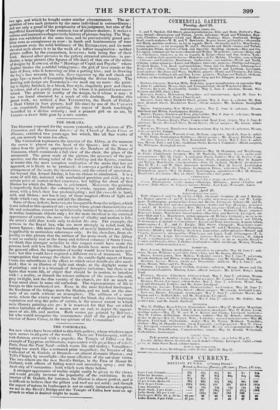THE DIORAMA.
Tits Diorama reopened for the season yesterday, with a picture of The Coronation, and the furious bteri4::• of the Church uf Santa Croce at Florence, exhibited two years ago, but -which, like all fine works of art, can scarcely be seen too often. The Coronation represents the interior of the Abbey, at the moment the crown is placed on the head of the Queen ; and the view is taken from the gallery appropriated to the Members of the House of Commons, which commands a full view of the choir, the place of the ceremonial. The great scale of the picture, the accuracy of the per- spective, and the strong relief of the building and the figures, combine to render this the most complete realization of the scene that has yet appeared, or is likely to be produced : it conveys a perfect idea of the arrangement of the seats, the decorations, and the crowd of spectators ; but beyond this formal fidelity, it has no claims to admiration. It is a scene of still life, imitated with mechanical precision and skill, up to a certain point of matter-of-thet exactness, bat filling far short of that illusion for which the Diorama is celebrated. Moreover, the painting is imperfectly finished; the colouring is crude, opaque, and inharmo- nious, with a brick-dust hue predominating and the en,s.emble is hard, cold, and lifeless: nor has it any of those magical effects of light and shade which vary the scene and aid the illusion.
Some of these defects. however, are inseparable from the subject, which is not suited to this species of art : a scene whose grand characteristics are life and animation, cannot be satisfactorily imitated by means calculated to realize inanimate objects only ; for the more identical is the external appearance of nature, the more the want of vitality and,motion is felt ; the artist's skill thus tends only to defeat his aim. For example, the persons in the Royal box, who are most strongly in relief, look like waxen figures : this marks the boundary of incrcly imitative art, which is applicable to motionless substances only. So fir, therefore, from ob- jecting to this picture that the surffice of the stone-work of the Abbey is not so entirely real as the damp and defficed columns of Santa Croce, we think that stronger actuality in this respect would have made the persons look still less life-like : had the details been more sacrificed to the general effect, the impression of reality would have been more per- fect; but this would have required a different style of treatment. The congregation that occupy the chairs in the candle-light aspect of Santa Croce are subordinate to the effect, to which other details are also sacri- ficed: this is an illusion of light and shade, as the daylight scene is of painting; and it is a triumph of deceptive imitation ; but there is no figure that wants life, or object that should be in motion, to interfere with te reality, or disturb the solemn stillness of the scene—the cold, gray twilight, and the dim vacuity of the church, are felt as much as if one stood alone in some old cathedral. The representation of life is foreign to this mechanical art. Even in the most finished landscapes, the fixedness of the foliage mars the illusion, and we look on the ano- maly of an earth without an atmosphere. The stillness of a snow scene, where the wintry waste below and the blank sky above imprison vegetation and stop the pulse of nature, is the utmost extent to which mere illusory painting can go : it is reserved for that fine art which makes imitation of objects a means, not an end, to depict the appear- auces of air, life, and motion. Both scenes are painted by BorToN ; but who would recognize the consummate skill of the painter of the interior of Santa Croce, in the toy-picture of the Coronation?


























 Previous page
Previous page